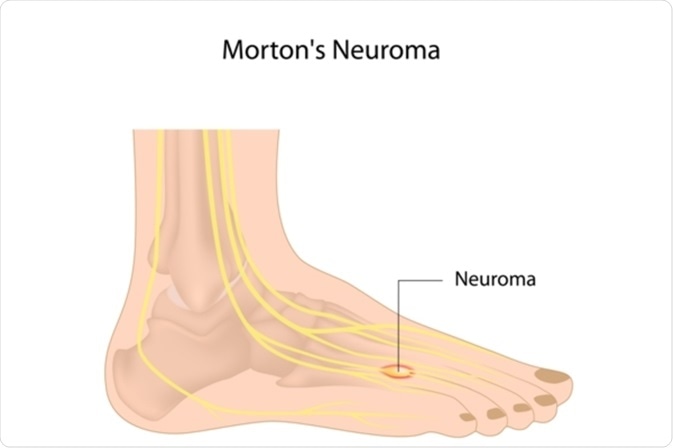The optimal treatment of Morton’s neuroma will depend on individual characteristics of the condition, such as the duration and severity of the symptoms.

Image Credit: Alila Medical Media / Shutterstock.com
For most patients, non-surgical techniques are able to provide effective relief from pain and other associated symptoms and less than 20% of patients will require surgical treatment.
Conservative treatment
The initial step in the treatment plan of Morton’s neuroma should be to identify and remove any causes that are likely to have caused damage to the nerve and the resulting symptoms.
Ill-fitting footwear that is pointed-toe, high-heeled, or too tight can increase the stress placed on the nerve and result in damage. If footwear is a likely causative factor, changing footwear for a more comfortable fit with more support and less pressure on the nerve can help to improve symptoms.
Similarly, people who participate in high-impact sports such as running are also prone to Morton’s neuroma, particularly if they wear ill-fitting or worn-out shoes. Taking rest and avoiding participation in these sports while the nerves recover can help to manage the condition.
Orthotic devices can also help to relieve pressure on the nerve. These devices act as a soft pad placed under the ball of the foot inside the shoe, which can reduce pressure on the nerve. Other non-surgical treatment techniques include massaging or applying an ice pack to the affected toes.
Pharmacological treatment
Pharmacological management typically involves the use of simple analgesic medications, such as paracetamol or non-steroidal anti-inflammatory drugs (NSAIDs), to ease the pain.
Additionally, corticosteroid and anesthetic injections administered directly to the affected area between the toes can help to relieve more severe pain. This may cause some numbness of the toes that will subside shortly after the injection.
Surgical treatment
For severe cases of Morton’s neuroma, surgical intervention may be required to relieve pain if other techniques were not successful.
The surgical procedure is usually carried out under general or local anesthesia. The procedure involves a small incision into the foot that allows direct access to the nerve and the removal of either some of the surrounding tissue and/or part of the affected nerve.
The procedure helps to create more space in the inflamed area and relieve pressure. If some of the nerve is removed, the patient will experience permanent numbness in the area between the toes.
Following the procedure, the patient should wear specialized footwear to protect the affected area until it heals sufficiently to wear normal shoes. Most people can move independently shortly after the procedure but usually need several weeks or months before recovering completely to participate in daily activities and sports as usual.
There is a small risk of complications when undergoing surgery, such as inflammation, pain, and infection. It is important that the patient is aware of these risks and the optimal treatment decision for the individual is made based on the possible risks and benefits of surgery.
Other treatments
Other treatments that are sometimes used for Morton’s neuroma include extracorporeal shockwave therapy, radiofrequency ablation, and cryotherapy or cryosurgery.
Extracorporeal shockwave therapy involves the administration of shockwaves to reduce the pressure due to nerve enlargement, whereas radiofrequency ablation utilizes thermoneurolysis to heat the nerve and release the pressure in the area. Cryotherapy or cryosurgery are emerging treatment options that involve the use of a probe inserted into the foot to freeze and destroy the damaged nerve.
References